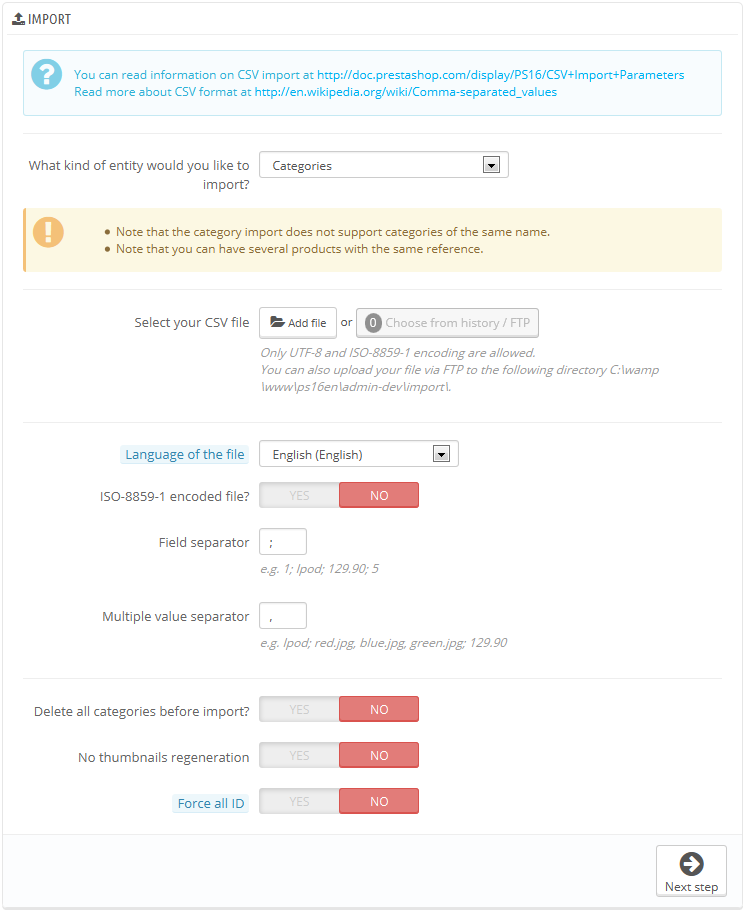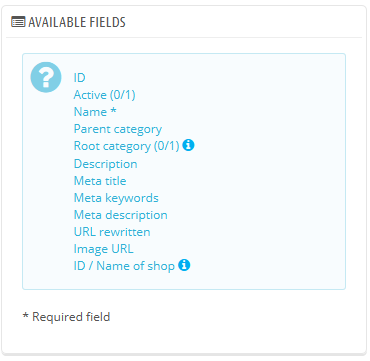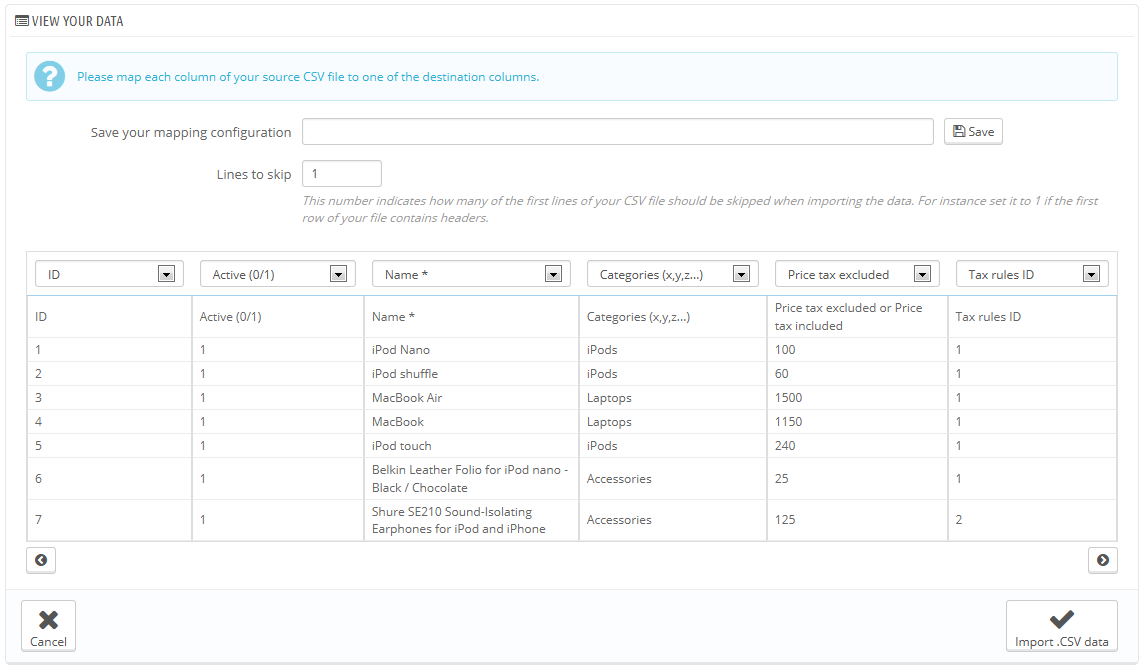
La página de importación CSV le permite introducir fácilmente una gran cantidad de productos a su catálogo, o importar datos que exportó y convertió desde otra herramienta de comercio electrónico.
CSV es un acrónimo de "valores separados por comas". Es es un un archivo de texto plano que se utiliza cuanto hay una necesidad de importar, exportar o simplemente almacenar datos en un formato no propietario. Puede obtener mayor información sobre el formato CSV en el siguiente enlace de la Wikipedia: http://es.wikipedia.org/wiki/CSV. |

El proceso de importación requiere de la preparación del archivo CSV, y cumplimentar el formulario que presenta la configuración principal:
Elegir un archivo CSV para importar. Puede importar más de un archivo a la vez, pero asegúrese de que todos ellos contienen el mismo tipo de datos.
Puede descargar archivos de ejemplo para cada tipo de datos desde la sección de la derecha "Descargue ejemplos de archivos CSV". Esto le ayuda a comparar estos archivos de ejemplo con sus propios archivos creados, de esta manera puede asegurarse de que los archivos que va a importar están realmente preparados para ser importados a PrestaShop. Estos archivos se almacenan realmente en la carpeta |
Idioma del archivo. Los datos solamente pueden ser importados para un simple idioma al mismo tiempo. Si sus datos utilizan más de un idioma, debe dividirlos en tantos archivos como idiomas tenga.
Cuando cambie el ajuste Entidad, la sección de la derecha, titulada "Campos disponible", cambia para presentar los campos de datos que se esperan. Aunque la herramienta de importación está diseñada para ayudar a PrestaShop a encontrar los campos en el archivo, debe esforzarse para que la importación de datos sea lo más amigable posible, siguiendo el esquema de nombres y el orden de los campos presentados. En caso de que esto no sea así, la importación de datos será más tediosa, pero no imposible.
Algunos de estos campos tienen un pequeño icono de información (representados por un icono "i"), que muestran una ventana emergente si situa el cursor del ratón encima de ellos. La mayoría de ellos hacen referencia a la funcionalidad multitienda o al gestor avanzado de existencias de Prestashop. Asegúrese de leer todas estas informaciones para crear / editar los archivos de datos de forma correcta.

Los datos importados deben estar en un archivo de texto con extensión .csv, con los distintos valores de campos debidamente separados. Le recomendamos que utilice un punto y coma ";" como separador de campos. Si sus datos textuales (tales como descripción del producto) contienen carácteres punto y coma, deberá eliminarlos o elegir otro separador en la opción "Separador de campos".
Puede crear un archivo de este tipo con cualquier editor de texto (como por ejemplo Notepad++: http://notepad-plus-plus.org/), pero le aconsejamos que utilice un programa que le permita trabajar con hojas de cálculo, y posteriormente guarde su trabajo en formato .CSV. En una hoja de cálculo puede trabajar visualmente más rápido, en comparación con un archivo de texto plano. Puede utilizar un programa de pago como Microsoft Excel: http://office.microsoft.com/es-es/excel/, o bien una alternativa libre y gratuita como OpenOffice Calc: http://www.openoffice.org/.
Este es un ejemplo de como sería el resultado final de un archivo preparado para importar una lista de productos:
"Enabled";"Name";"Categories";"Price";"Tax rule ID";"Buying price";"On sale";"Reference";"Weight";"Quantity";"Short desc.";"Long desc";"Images URL" 1;"Test";"1,2,3";130;1;75;0;"PROD-TEST";"0.500";10;"'Tis a short desc.";"This is a long description.";"http://www.myprestashop/images/product1.gif" 0;"Test 02";"1,5";110;1;65;0;"PROD-TEST2";"0.500";10;"'Tis also a short desc.";"This is a long description too.";"http://www.myprestashop/images/product2.gif" 1;"Test 03";"4,5";150;1;85;0;"PROD-TEST3";"0.500";10;"'Tis a short desc. again";"This is also a long description.";"http://www.myprestashop/images/product3.gif" |
Note that this is only a regular sample files built for this demonstration; it is purposefully not optimized for PrestaShop importation. If you need a sample file you can learn from, use the ones you can download from the "Upload" button's form.
The first row should be a descriptive name for the data column (you will be able to skip it during the import process). There must be the same number of columns on each row.
You should remember that:
2013-06-21 15:07:27.Once you have all your data in CSV format, you can upload them to your store's database using the form in this page.
You have two ways to register files to import:
/admin-dev/import folder of your PrestaShop installation. Reload the import page: the "Choose from history/FTP" button should now indicate a number. Click the button to display the list of available files (including the ones you previously uploaded using the browser), then click the "Use" button for the file you wish to import.Once your files are all listed in the "Select your CSV file" section, you can proceed with the rest of the form:
;", "multiple value separators" with a comma ","). But obviously, if your CSV file is built differently, you should change these values accordingly.All import files are uploaded directly in the admin folder's |
When clicking the "Next step" button, the page reloads with the data mapping tool. This interface helps you map you file's data columns with the ones required by PrestaShop.

Presented in this table are the rows from your CSV file, placed under arbitrary columns matched to PrestaShop's database needs. It is up to you to make sure that all the columns from your CSV file are matched with the correct column header, using each header's drop-down selector, so as to import your content correctly.
For instance, with our sample file:
The screen cannot contain more than 6 columns, so click the ">" and "<" buttons to see the other columns, and make sure to match them all correctly.
In our example, we used the first row as for column names. Since we do not want these imported, enter "1" in the "Lines to skip" text-field.
Once you are done matching your columns, click the "Import .CSV data" button (bottom right-hand corner of the screen), and PrestaShop will start the importing process. When the process is done, you are sent to the main screen, which should either confirm that everything has indeed been imported, or give you a notice of all the encountered problems. In this second case, you should review your CVS file and make sure to correct everything.
The mapping process can be a tedious task if you cannot customize your CSV files columns order according to that used by the PrestaShop importer, and even more so if you have to do that repeatedly or frequently. That is why PrestaShop includes a small tool to save the current mapping order that you have set up using all the headers drop-down selectors.

The tool is a simple field at the top of the matching tool. You can do the three basic actions (only one if there is no mapping configuration saved yet):